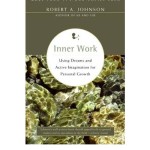Active Imagination is a powerful tool to explore the subconscious forces within us and to unlock what is hidden there for use in our work. I first learned about Active Imagination in the ’80s when I read Robert Johnson’s Inner Work.

In the book, he teaches us how to mine the powers of dream life and to activate these forces into waking life. He also teaches Active Imagination: a process of conscious engagement with the mythic and subconscious forces within us. These forces contain important guidance not often available by other means. We can call on these forces when we’re blocked in life or blocked in story. In the thirty years that I’ve been using Active Imagination, I’ve yet to leave a session with my challenge or question unaddressed or unanswered. Johnson’s book (and others) is widely available. Read it. Read on for a taste of how this i this technique might serve you.
To clarify, dreams are not the same as Active Imagination. We dream when we are asleep/unconscious and passive. We actively use Active Imagination while awake/conscious. Active Imagination invites us to participate actively in an imaginative state that is neither conscious or unconscious. It is a plane where these terrains come together.
The technique invites us to engage in a dialogue with feelings or forces and then to do something about what we learn there. Active Imagination provokes real experiences. These experience result from real feelings in the imaginative realm. The focus is on asking and then listening and replying respectfully.
The technique has a couple of parts: The Dialogue and The Ritual.
The Dialogue:
- Get in touch with the feeling or force. Feel it or imagine feeling it. Personify the unseen content of the subconscious. This could be a feeling you have (e.g. worry) or the force that informs a story person/character. No need to dress it up. There is no audience. This is private between you and your unconscious.
- Ask: Where is the feeling? Who is obsessed? Who is the one inside me that feels this way? What is its image? What does s/he look like?
- Be curious. Focus on listening and replying in full participation. Note: You bring the ethical. Follow where the person/image takes you only if it feels right/ethical to do so. If you don’t want to, you get to say so. You bring the human choice.
- Take notes. There is no set amount of time to engage. Follow your gut.
The Ritual
Ritual integrates what you’ve learned into waking life (i.e. writing).
- Ask your image how you might integrate what you’ve learned into your work. Note: If you think you’re faking it — you’re not.
- Pay attention to the objects, smells, feelings, sounds, heights/widths (dimensions), materials, sensations, etc. that emerge directly or are provoked in the session. If you’ve worked with me before, you likely have heard of and engaged with ‘traces’. These are great tools with which to integrate what we learn in Active Imagination sessions.
For instance, if a character is worried but you haven’t quite solved how to craft that I might do an Active Imagination session. Out of that I take nails tapping on a counter, a whacking cable on a flag pole, the key my character can’t find, etc. From this will come the rhythm, words and state of ‘worry’. You might be surprised at the originality that will emerge.
Try this: After a session, you might look for places where a story person in your work might be faced with the content and sensual qualities of your session. The content could be a part of present circumstances, a part of setting, a word, a habit, a gesture — how you use what you learn is wide open.
You’ll discover how to craft it on the page and your reader will feel it. Report back.
If you’d like to enrol in a workshop, check out the WCTO page.
